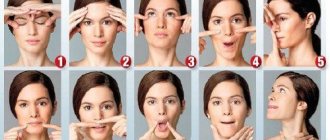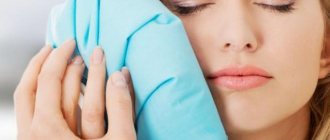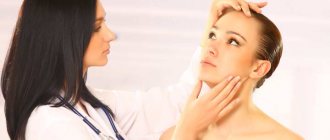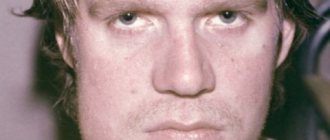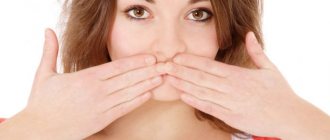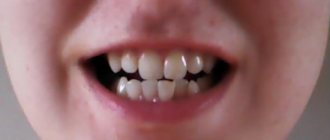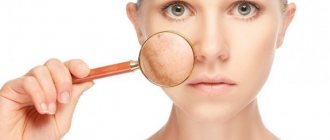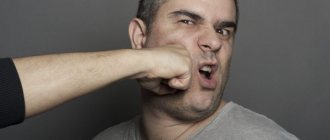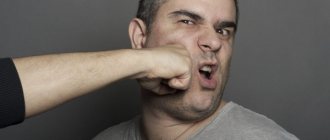Causes of clamping of the masticatory muscles
Severe spasm of the masticatory muscles can cause pain
Hypertonicity of the masticatory muscles is a stable, excessive increase in the muscle tone of the dentofacial apparatus, associated with overstrain of several groups of facial muscles:
- temporal;
- medial pterygoids;
- lateral pterygoids;
- cheek muscles.
With slight tension, a person experiences slight discomfort. Moderate and severe hypertonicity causes severe pain and spasm (trismus) on one or both sides. In such cases, the jaw contracts to such an extent that it cannot be opened. Most often, young women aged 20-30 years suffer from GFM.
Chewing and other muscles can become tense for a long time due to psycho-emotional overload, stress, diseases of the musculoskeletal system, or incorrectly placed fillings in the teeth. Hypertonicity is also caused by malignant and benign neoplasms in the brain, intracranial hemorrhage, meningitis, tetanus, rabies, and congenital defects in tissue development.
Anatomy of the masticatory muscles
Local causes of the pathological process are various diseases affecting the maxillofacial area:
- inflammation of bone tissue;
- periostitis of the periosteum, phlegmon;
- eruption of wisdom teeth;
- arthrosis, arthritis, dysfunction of the temporomandibular joint (TMJ);
- periodontitis, pulpitis;
- poor dental and orthodontic treatment, missing front teeth.
One of the provoking factors for the development of GFM is jaw injury (dislocations, cracks, fractures) associated with sports, household, and professional activities.
Facial and leg cramps - causes. What to do if you have facial cramps?
Facial cramps - main symptoms: Cramps Cramps of the calf muscles Facial cramps
Cramps are involuntary paroxysmal contractions of muscles, their twitching.
Convulsions of the face, legs and any parts of the body can be tonic or clonic. Tonic cramps are muscle tension called spasms. The clonic variant of seizures is considered an involuntary muscle twitching.
A combination of them is possible. We are talking about tonic-clonic seizures.
Also, seizures are divided into partial and general . Partial cramps are cramps that occur in a specific muscle group. Their appearance may be associated with stereotypical movements and muscle strain, as well as hypothermia, etc.
Local cramps that occur in the muscles of the hand, foot, trunk and face can occur due to serious damage to the area of the brain that is responsible for the innervation of this muscle group. In this case, the occurrence of seizures will be observed on the side opposite to the lesion.
General convulsions (generalized) are a consequence of epileptic syndrome, as well as a complication of intoxication, traumatic brain injury and an infectious process.
Possible causes of seizures
- Hyperkinesis is considered violent excessive movement. Hyperkinesis can act as a symptom of various pathological conditions, such as chorea minor, cerebral palsy, damage to the extrapyramidal system in the form of athetosis, chorea, myoclonus, hemiballismus, torsion spasm, etc.
- Facial hemispasm is a clonic or tonic spasm that typically occurs on one side of the face for about 2 minutes.
This is manifested by closing the eyes, pulling the mouth to the side and tonic tension of the neck muscles in the form of a tonic half mask. As a rule, the cause of facial hemispasm is damage to the facial nerve of the cortical-nuclear type. - Idiopathic hemispasm. It is a variant of seizures with an unknown etiology.
- The occurrence of symptomatic hemispasm is associated with compression of the facial nerve (caused by tumor and blood vessels), multiple sclerosis, neuropathy of the facial nerve, and a tumor process in the parotid gland.
As a rule, an attack is provoked by facial movements, chewing, and squinting. This type of seizure cannot be controlled. Symptomatic hemispasm is characterized by persistence during sleep. - Differential diagnosis of a possible cause of seizures requires MRI, angiography, electroneurography, etc. Detection of compression of the 7th pair of cranial nerves by vessels or a tumor requires a solution to the issue of surgical treatment.
Anticonvulsants (carbamazepine) and muscle relaxants (mydocalm) are used for treatment. Acupuncture is also recommended. Prescription of drugs is carried out by a doctor. - Blepharospasm is an involuntary contraction of the orbicularis oculi muscle, which can be tonic or tonic-clonic in nature. Blepharospasm is manifested by rapid blinking.
It can be the result of torsion dystonia, a tumor process in the brain, stroke, degenerative disorders of the nervous system, as well as poisoning with drugs such as antipsychotics, lithium drugs, antidepressants, etc.It is worth considering that unsuccessful tooth extraction, prosthetics, facial trauma, overstrain of facial muscles and visual stress can also be complicated by blepharospasm. In most cases, its appearance is typical for 50-60 years of age. This disease is chronic and progressive. After sleep, as a rule, there is an improvement in the condition for several hours.
Blepharospasm is characterized by the presence of corrective gestures. We are talking about touching the upper half of the face, taking off and putting on glasses. This helps reduce the frequency of blinking. The occurrence of a reflex spasm can be observed when the anterior parts of the eye are affected (glaucoma, conjunctivitis, iridocyclitis). Therapy for blepharospasm is the same as for facial hemispasm.
- Tick century.
This disease is a consequence of nervous tension and stress. A mild form of tic is characterized by self-healing. More severe forms include taking valerian, dormiplant, novopassit, sedavit, and tranquilizers. These drugs belong to the group of sedatives. - Facial paraspasm.
It is otherwise called Intermediate spasm. It is bilateral tonic or tonic-clonic hyperkinesis. It is considered to be a consequence of damage to the subcortical nodes. - Spasmodic torticollis is a form of local hyperkinesis.
It is manifested by involuntary turns of the head and neck and unilateral tonic and tonic-clonic convulsions in the neck muscles. The development of spastic torticollis can be caused by congenital anomalies, torsion dystonia, and pathology of the extrapyramidal system. - Writer's cramp is a disorder of the motor function of the hand and fingers, which is associated with prolonged writing and neuro-emotional stress. Painful muscle cramps brushes appear when trying to write.
Such convulsive contraction of the hand muscles is also found in pianists, violinists, dancers, milkmaids, etc. All these cases are caused by overstrain of individual muscle groups. The initiation of therapy is based on the exclusion of more serious causes of the disease. We are talking about minor chorea, hepatolenticular degeneration, etc.During treatment, it is acceptable to stop the activity that caused the muscle strain. Treatment includes the appointment of muscle relaxants, tranquilizers, physical therapy, massage, reflexology and B vitamins.
- Myoclonus is the name given to small spasms and twitchings that occur in individual muscle fibers in diseases such as encephalitis and Kozhevnikov epilepsy.
- Cramps are painful, short-term cramps in the foot and calf muscles.
Crampia typically appear at night. There is painful muscle tension, flexion of the foot and cramping of the toes. This leads to the fact that a person wakes up from a feeling of severe pain and discomfort. Cramps are symptoms of diseases of the central nervous system, peripheral nervous system, pathology of internal organs and muscles, as well as endocrine problems, etc. - It should be taken into account that cramps occur due to nervous strain, physical exertion, alcohol, smoking, hypothermia, low blood sugar, etc. The examination is carried out by a doctor. First of all, the underlying disease is treated. Symptomatic therapy includes taking calcium with vitamin D3 and muscle relaxants. It is also acceptable to prescribe light massage, physical therapy and contrast water procedures.
- Hysteria may also be accompanied by a variety of convulsive symptoms. The patient is characterized by a smooth descent to the floor and bending in a tonic convulsion in front of many people. Such cases require consultation with a psychiatrist.
- A generalized convulsive symptom can act as a symptom of epilepsy, traumatic brain injury, poisoning and neuroinfection.
What to do if you have seizures?
The development of seizures requires taking analgesics and contacting a doctor. If an attack of convulsions occurs, it is necessary to massage the part of the body where they appeared. This measure is taken to improve blood circulation. Calcium deficiency seizures require eating foods that are rich in calcium.
What happens in muscles under heavy loads?
After one or more negative factors appear, the muscles are subjected to a single overstrain. Constant hypertonicity leads to the development of spasm. Painful sensations gradually weaken the muscle fibers as the person tries to immobilize the problem area.
Against the background of the pathological process, compensatory tension occurs in the muscles located on the opposite side of the jaw. In this case, the patient experiences pain in the area of the masticatory muscles, which intensifies when closing and opening the jaw. Additionally, a characteristic grinding or clicking sound appears in the TMJ area.
The patient can visually see zigzag changes in the jaw to the left, right or forward, which leads to the onset of bruxism (premature wear, abrasion of teeth). In some cases, pain is felt in the maxillary area, sinuses, ears, and brow ridges.
Trismus of masticatory muscles causes tooth wear
Characteristic symptoms of overstrain of the masticatory muscles include:
- swelling of the skin and jaw;
- high tooth wear;
- malocclusion and other deformations of the dentofacial apparatus;
- attacks of headaches and migraines;
- spasms, cramps, pain in the face.
Long-term clamped chewing muscles are a source of bruxism, headaches and toothaches. Therefore, at the first signs of the development of pathology, it is necessary to seek medical help.
Features and clinical picture
The disease mainly affects middle-aged people. Only about 30% of cases occur in people under thirty years of age. Women get sick twice as often.
Facial hemispasm is a periodically recurring spasm of the facial muscles.
The possible course of the disease can most often be characterized as follows:
- Typical. Infrequent twitching occurs around the eye. The entire half of the face is gradually affected, and the spasms become more intense. Vision in the affected eye is difficult or disappears.
- Atypical. Ascending contraction of the cheek muscles.
- Post-paralysis. Develops after paralysis from wounds, trauma, neuritis of the facial nerve. In this form, voluntary facial movements lead to involuntary twitching (on any part of the face); it is the most difficult to treat.
The nature of muscle contractions can be either clonic (tension followed by relaxation) or tonic (constant tension).
Spasms are absolutely painless, but can cause significant discomfort. May continue even during sleep.
When there is a pause between seizures, the face is symmetrical in most cases. But some patients experience weakness on the affected side: when smiling, one corner of the mouth is slightly drooping, and the symptom of “eyelashes” is observed (when the eyelids are tightly closed, the eyelashes do not sink into the folds of the skin, but stick out).
Patients often experience emotional swings, depression, and anxiety.
Diagnosis and treatment
Diagnosis of muscle hypertonicity
During the examination, the doctor pays attention to the person’s facial expressions, posture, head tilt, and neck movements when turning. The condition of muscle tissue during speaking and swallowing is assessed. The corneal reflex, range of jaw movements are checked, and it is determined whether there are problems with the spine.
The patient is prescribed an occlusiogram to determine the type, dynamics, and statics of the bite. If necessary, they give a referral for an X-ray of the TMJ, an orthopantomogram of the jaws, and an electromyography. Based on the diagnostic results, therapy is prescribed.
If the dentofacial muscles are overstrained, medications are used to relieve pain and relieve spasms. Injections of Botox, vitamins and muscle relaxants are prescribed. For treatment to be effective, it should be approached comprehensively, based on the main cause of the occurrence of GFM.
- dislocations and injuries require fixation of the jaw, rest, physical therapy or surgery;
- abscess and inflammatory processes are treated by opening the abscess, cleansing the cavity with further use of antibiotics;
- for arthritis and arthrosis, anti-inflammatory drugs are prescribed;
- If the cause of hypertension is psychosomatic disorders, neuroses, antidepressants and sedatives are prescribed.
In some cases, an effective method of combating GFM is wearing pre-orthodontic trainers, which protect teeth from premature wear. At the beginning of treatment, the patient experiences signs of bruxism. As a result, he learns to properly hold and control his tongue and not clench his teeth, which gradually helps relieve spasms.
If you have pain and trismus in the area of the masticatory muscles, you should consult a gnathologist, dentist, orthodontist, or osteopath.
Cramps of the face and legs
- 1 Reasons
- 2 Possible causes of leg cramps
Cramps of the face and legs
Cramps are involuntary paroxysmal muscle contractions and twitching. There are tonic and clonic spasms of the face and legs, as well as other parts of the body.
With tonic spasms, muscle tension occurs, which is called a spasm. With clonic seizures, involuntary muscle twitching occurs.
Sometimes these two types are combined, and then another type occurs - tonic-clonic seizures.
Seizures are also divided into general and partial. In the partial form, cramps appear in one muscle group. They can occur due to stereotypic movement and muscle strain, or due to hypothermia, etc. Local cramps occur in the muscles of the trunk, face, foot, and hand.
Their appearance is associated with serious damage to the area of the brain responsible for the innervation of a certain group of muscles. In such a situation, the manifestation of seizures will be observed on the side opposite to the lesion.
Epileptic syndrome, as well as complications of intoxication, traumatic brain injury and an infectious process can provoke the appearance of generalized (generalized) seizures.
Causes
- Hyperkinesis is violent excessive movement. They can be a symptom of various pathological diseases (chorea minor, cerebral palsy in children, destruction of the extrapyramidal system in the form of athetosis, chorea, myoclonus, hemiballismus, torsion spasm, etc.
- Facial hemispasm is a clonic or tonic spasm that occurs on one half of the face and lasts about 2 minutes. In this case, there is squinting of the eyes, pulling to the side of the mouth, and tonic tension of the neck muscles in the form of a tonic half mask. Often, facial hemispasm occurs due to damage to the nerves of the face in the cortical-nuclear form.
- With idiopathic hemispasm, seizures are combined with an unknown etiology.
- Symptomatic hemispasm.
The causes of such hemispasm may be compression of the facial nerve caused by a tumor and blood vessels, multiple sclerosis, neuropathy of the facial nerve, a tumor process in the parotid gland. This attack is provoked by facial movements, chewing and squinting. These types of seizures are uncontrollable. You need to give peace to your face in your sleep. - Differential diagnosis of the suspected cause of seizures can be carried out using MRI, electroneurography, antiography, etc. If compression of the seventh pair of cranial nerves is detected, surgical treatment is necessary.
During treatment, anticonvulsants (carbamazepine) and muscle relaxants (mydocalm) are used. It is also strongly recommended to undergo acupuncture. Only a professional doctor can prescribe medications. - With blepharospasm, an involuntary contraction of the orbicularis oculi muscle occurs, which is tonic or tonic-clonic in nature.
With blepharospasm, the patient experiences frequent blinking. This disease can also be caused by torsion dystonia, a brain tumor, stroke, degenerative disorders of the nervous system, drug poisoning: antipsychotics, lithium drugs, antidepressants, etc., as well as unsuccessful tooth extraction process, facial trauma, prosthetics, overexertion of facial muscles and visual stress. Very often, blepharospasm occurs in people aged 50 to 60 years. The nature of this disease is chronic and progressive. The condition improves only after sleep, but not for long.
With blepharospasm, corrective gestures are also characteristic - this is touching the upper half of the face and frequent dressing - taking off glasses. This allows you to reduce the frequency of blinking. The appearance of a reflex spasm can often be associated with damage to the anterior parts of the eye (iridocyclitis, conjunctivitis, glaucoma). The treatment for blepharospasm is the same as for facial hemispasm.
- Tick century. Occurs due to nervous tension and stress. In case of a mild form of the disease, self-healing is encouraged, and in case of a more severe form, it is recommended to start using valerian, sedavit, novapassit, dormiplant and tranquilizers. These drugs belong to the group of sedatives.
- Facial paraspasm (Mezha spasm) is a bilateral tonic or tonic-clonic hyperkinesis. Occurs due to the destruction of the subcortical ganglia.
- Spasmodic torticollis is a form of local hyperkinesis.
It occurs as a result of involuntary turns of the neck and head, unilateral tonic and tonic-clonic convulsions in the neck muscles, and torsion dystonia, congenital anomalies, and pathology of the extrapyramidal system can also lead to the development of the disease. - Writer's cramp is a disorder of the movement of fingers and hands that occurs due to prolonged writing and neuro-emotional stress. When you try to write something with your hand, cramps of the hand muscles occur, accompanied by pain. Pianists, violinists, dancers, milkmaids, etc. are most often susceptible to writing cramps, as they often strain certain muscle groups.
Therapy for this disease is carried out only in serious forms of the disease, such as chorea minor, hepatolenticular degeneration, etc. During treatment, it is necessary to stop engaging in activities that provoked muscle strain.Treatment occurs with the help of recreational physical education, tranquilizers, muscle relaxants, reflexology, massage, and B vitamins.
- Myoclonus refers to small twitches and convulsions that occur in individual muscle fibers during encephalitis and Kozhevnikov epilepsy.
- Cramps are painful cramps in the foot and calf muscles that do not last long.
Very often the disease bothers you at night, muscles tense, feet bend and fingers cramp - all this leads to sleep disturbances, the person wakes up from severe pain. Cramps can be symptoms of diseases such as the central nervous system, diseases of the peripheral nervous system, pathology of internal muscles and organs, endocrine problems, etc. - It should be noted that the occurrence of cramps is associated with nervous overstrain, frequent physical activity, alcohol, smoking, hypothermia, low blood sugar, etc. For examination, you must consult a doctor. Symptomatic therapy includes the use of calcium with vitamins D3, as well as muscle relaxants. During treatment, light massage, physical therapy and contrast water procedures are prescribed.
- Hysteria is also accompanied by a variety of convulsive symptoms. The patient experiences a smooth descent to the floor, and then bends over in a tonic convulsion in front of many people. This disease requires the intervention of a psychiatrist.
- Generalized seizures can be a symptom of diseases such as epilepsy, traumatic brain injury, poisoning and neuroinfection.
Possible causes of leg cramps
- Possible causes of leg cramps Disruption of the circulatory system. With this disorder, the patient experiences chronic venous insufficiency, varicose veins and thrombophlebitis.
- Disruption of arterial blood flow with obliterating arterial atherosclerosis of the lower extremities, changes in the walls of blood vessels with low blood sugar, etc.
- Disturbed innervation of blood vessels and soft tissues of the lower extremities.
It is very important to seek medical help for any form of cramping in the legs or any other parts of the body. The nature of diagnosis and prescription depends on the objective condition.
What to do if you have seizures?
If you notice that you are experiencing seizures in newborn babies, then you need to start taking analgesics and be sure to consult a doctor.
If an attack of leg and face cramps occurs, you should massage the part of the body where the cramps are observed. This will help improve blood circulation.
Cramps caused by calcium deficiency are treated by eating calcium-rich foods.
Which doctors should you seek help for seizures?
If you have a seizure, you will need to consult the following doctors:
- Therapist,
- Vascular surgeon,
- Dermatologist,
- Endocrinologist,
- Neurologist.
These doctors will correctly determine the form of convulsive symptoms and disease and prescribe good treatment (if necessary).
about cramps in the legs and other parts of the body
Source: https://SimptomLecheniye.ru/sudorogi-lica-i-nog.html
Relieving spasms at home
The absence of discomfort with an open mouth indicates the normal state of the masticatory muscles
Every person can independently check whether there is a jaw clamp. You should place three folded fingers vertically between your teeth and assess your condition. If there is no discomfort, you can hold your jaw in a slightly open position for a long time, there are no problems with the muscles. If your fingers do not fit in your mouth, you feel pain - you urgently need to relax.
An urgent need to relax the hypertonicity of the masticatory muscles faces people who:
- when opening the mouth, the joints click and crunch;
- there is a habit of gritting your teeth when walking, reading, working at the computer, communicating with unpleasant people, etc.;
- the thinning of the subcutaneous fat layer in the area of the masticatory muscles is determined by touch;
- The dentist diagnoses severe tooth wear.
To relieve hypertonicity of the jaw muscles, you need to relax as much as possible. During a spasm, you should not eat (chew), smoke, laugh, or talk. It’s worth switching to something calming – watch your favorite movie, read, meditate. The painful area can be massaged to increase blood circulation. Smooth the forehead from the center to the temples, go down to the corner of the lower jaw, walk along the cheeks - from the nose to the ears. It is also recommended to apply a cold compress for 10 minutes, and then a warm one, alternating heat and cold several times.
It is very difficult to completely relax spasmodic muscles without improvised means, so they are stretched using a wine cork. It is inserted between the front teeth and they try to hold it for 15-20 minutes. The size of the plug is selected so that there is no painful discomfort during gymnastics.
Exercises for cramped muscles
Gymnastics to relax the masticatory muscles
There are gymnastics for removing clamps and muscle lockjaw:
- They open their mouth, imitating surprise, and try to sit without closing their jaw for the maximum amount of time. The exercise is done regularly to wean yourself from clenching your jaw and overstraining your chewing muscles.
- Sit down straight, relaxing your neck. The fingertips are placed under the left zygomatic arch at the base of the masticatory muscles. Lightly press on the skin, opening the mouth slightly. Smoothly, in a circular motion, move down, then up again.
You can relax your jaw by pressing your palms to your cheeks, covering the jaw joint. Then slowly lower the lower jaw down and lift it, as if it were a ladle filled with water - strictly vertically. There should be no pain symptoms during gymnastics.
Taping the masseter muscle
When you manage to relieve muscle tension in the face and jaw, the body begins to relax. If the jaw is cramped and the teeth are clenched to the point of grinding, the neck, shoulders, and pelvic area also become toned. Facial muscle taping is an additional therapy method. It is carried out after massage and gymnastics. The tapes are attached to the entire problem area and removed after a day. After application there is relief. The duration of the course lasts 30 days.
Expelling tongue spasm
An expelling tongue spasm is the rarest of the tongue spasms. It is expressed in the fact that the tongue stretches horizontally and freezes, going beyond the edges of the teeth.
This is similar to tonic tension and often the tongue twitches, leaving the mouth and returning back. In some cases, the tongue rests on the lower teeth or lower jaw.
We suggest you familiarize yourself with How to get rid of bitterness in the mouth - treatment at home with drugs and folk remedies
The patient feels prolonged and sometimes painful muscle tension.
Possible complications
With a wide yawn, subluxation of the jaw joint is possible
If hypertonicity of the muscles of the jaw, face, and forehead is left without medical attention, this can negatively affect other organs and systems of the body. As a result you will see:
- pain in the neck, shoulders, jaw muscles;
- frequent headache, tinnitus, dizziness;
- dental hypersensitivity;
- Jaw popping out when sneezing, yawning;
- deterioration of visual acuity.
Lack of treatment for spasm leads to hypertrophy - an increase in the volume of the masticatory muscles. As a result, the face expands downward, acquiring an unusual square or triangular shape. The corners of the mouth droop, the nasolabial and labiomental folds deepen, and the lower part of the face becomes heavier.
What to do if your muscles cramp frequently, for a long time, constantly?
Frequent seizures not only reduce a person’s quality of life, but can also intensify in the absence of measures to eliminate the cause of their formation. The danger of prolonged muscle contraction lies in disturbances in blood circulation during this period, which can lead to pathologies of the vital systems of the body (for example, the development of varicose veins or thrombosis of the extremities).
If muscles throughout the body cramp more than once a month, you should consult a therapist. The doctor, having collected the necessary information, will independently prescribe treatment or refer the patient to a specialist.
Prevention of pathology
Do not bite hard foods with your teeth
Hypertonicity of the muscles of the face and jaws can be avoided if you visit the dentist every six months, maintain oral hygiene, be sure to treat diseases of the teeth and gums at the first symptoms, and also:
- in case of malocclusion pathologies, carry out timely correction;
- wash vegetables and fruits before eating;
- In case of wounds or animal bites, get a tetanus vaccination;
- Avoid stress, severe anxiety, and mental stress.
Being under constant stress and experiencing psycho-emotional stress, a person involuntarily clenches his jaw, which leads to muscle hypertonicity. To let your face relax, you need to develop useful habits:
- try to constantly keep your lips in a closed position, place your tongue raised to the palate, and not between the front teeth;
- do not open your mouth wide during loud conversations, and when yawning, support your lower jaw with your palm;
- do not eat excessively hard foods, avoid foods that require thorough chewing (popcorn, soft bread, raw carrots);
- If you have problems with your jaw, include in your diet food that is not difficult to chew (eggs, porridge, soup, puree, yogurt).
Psychosomatics is not the only provocateur of hypertonicity and spasm of the facial muscles, therefore the causes of the pathology and treatment methods are determined by a specialist. The problem should not be ignored, since in advanced cases, disorders occur in the body, accompanied by pain, dizziness, and blurred vision.
Unilateral numbness and pain in the tongue
Loss of sensation on one side of the tongue very often indicates damage to the lingual nerve. This is one of the largest branches of the mandibular nerve. It innervates the anterior part of the tongue, however, in the presence of certain disorders, attention should also be paid to the posterior part, for the innervation of which the glossopharyngeal nerve is responsible.
Patients usually complain of loss or significant decrease in taste sensations, while sensitivity in the second half of the tongue and oral mucosa is completely preserved.
To make a diagnosis, it is important to determine that the sensory impairment is limited to the tongue and does not affect the parts innervated by the inferior alveolar nerve: this area covers the lower parts of the oral cavity and the teeth of the lower jaw. If such a symptom is present, the damage is most likely localized in the oral cavity, closer to the angle of the lower jaw.
Iatrogenic damage. The most common cause of such damage is the removal of the second and third molars. The nerve can also be damaged as a result of osteotomy or similar surgical procedures, as well as during incision of a sublingual abscess.
We suggest you familiarize yourself with Ketorol injections when they begin to work
A limited inflammatory or neoplastic process in the lateral region of the back of the mouth also causes loss of sensation in the tip of the tongue.
Inflammation can lead to nerve damage due to pressure or exposure to toxins. The presence of a tumor also becomes a provoking factor.
